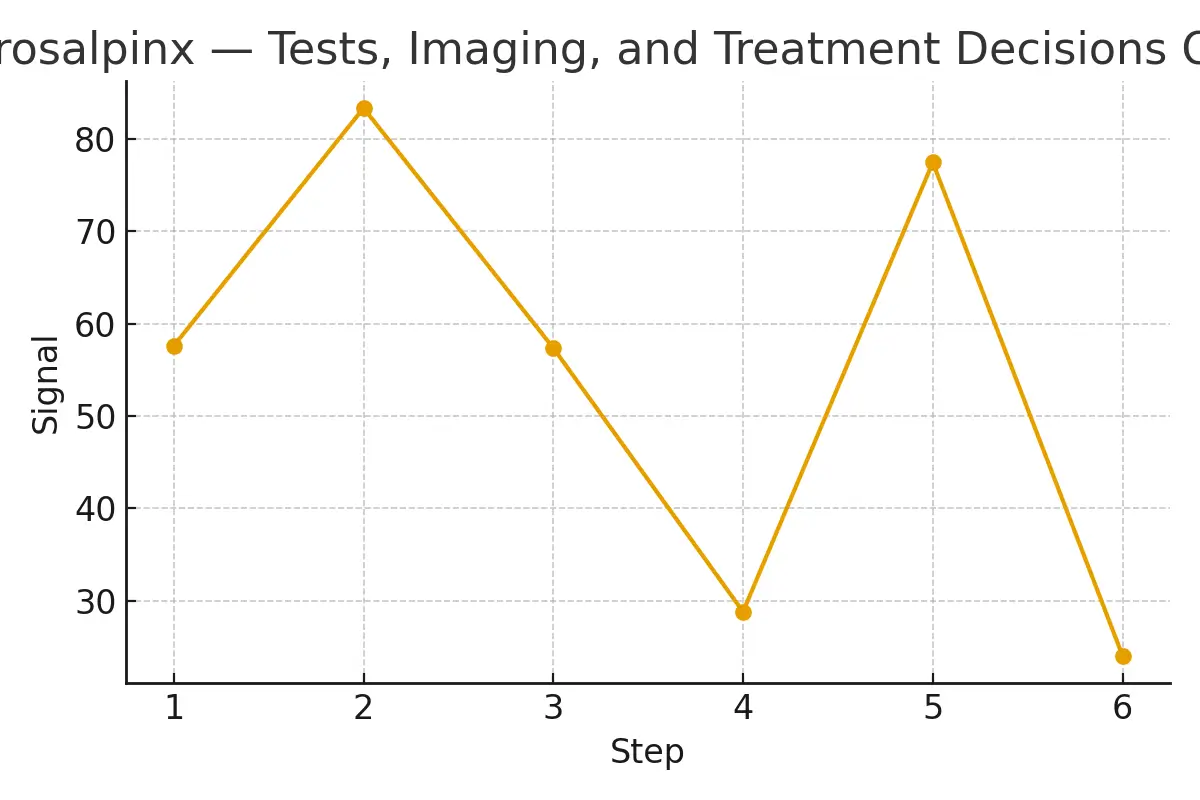
Understanding hydrosalpinx is an important step in the fertility testing and diagnostics journey. This condition can impact fertility outcomes, treatment planning, and overall success rates in IVF or natural conception. This guide explains the key steps — from diagnosis to treatment — and how to make informed, cost-conscious, and timely decisions with your fertility team.
1. What Is Hydrosalpinx and Where Does It Fit in the Journey
Hydrosalpinx refers to a fluid-filled fallopian tube, usually caused by previous infections, pelvic inflammatory disease, or endometriosis. The blocked tube collects fluid that can interfere with egg pickup or embryo implantation.
In the fertility testing pathway, hydrosalpinx is typically identified during imaging or laparoscopy, especially when patients experience delayed conception or unexplained infertility. Detecting it early ensures that corrective steps are built into the fertility plan — before IVF cycles begin.
2. Eligibility Signals and When to Escalate or Pause
Not every patient requires immediate surgery or IVF. Decision timing depends on fertility goals, age, ovarian reserve, and the extent of blockage.
Escalate testing or treatment if:
- Imaging shows fluid distention in one or both tubes.
- You have recurrent failed embryo transfers or chemical pregnancies.
- There is a history of pelvic infections or prior tubal surgery.
Pause or monitor if:
- Tubal damage appears minimal.
- Hydrosalpinx is unilateral and does not impact ovarian response.
- Your doctor recommends conservative observation before IVF.
A well-timed escalation helps reduce unnecessary interventions while preserving fertility potential.
3. Step-by-Step with Timing Checkpoints
The diagnostic and treatment process follows structured timing checkpoints to maintain clarity and reduce delays.
Step 1: Baseline Evaluation
Blood tests, ultrasound, and a Hysterosalpingogram (HSG) assess the reproductive organs and identify fluid presence.
Step 2: Imaging Confirmation
Advanced imaging, such as Sonohysterography (SHG) or laparoscopy, confirms blockage and defines the severity.
Step 3: Clinical Discussion
Your fertility specialist reviews test results, explains implications for IVF or natural conception, and suggests a plan — either surgical correction or IVF bypass.
Step 4: Treatment Execution
Depending on your pathway:
- Salpingectomy (tube removal) before IVF improves outcomes.
- Tubal clipping prevents toxic fluid from reaching the uterus.
- IVF with embryo transfer may proceed post-recovery.
Timing each step properly prevents redundant cycles and protects ovarian health.
4. Pros, Cons, and Practical Costs with Line-Item Examples
Every fertility decision involves trade-offs between outcomes, comfort, and budget.
Pros
- Early detection supports higher IVF success rates.
- Surgical management can restore natural fertility in some cases.
- Defined timelines simplify emotional and financial planning.
Cons
- Surgery adds short-term cost and recovery time.
- Repeated imaging may extend timelines.
- Hydrosalpinx recurrence is possible in untreated tubes.
Typical Cost Breakdown (Approximate)
| Service | Estimated Range (USD) |
| Diagnostic Imaging (HSG/SHG) | $300 – $800 |
| Laparoscopy or Salpingectomy | $2,500 – $6,000 |
| IVF Cycle (post-surgery) | $10,000 – $15,000 |
| Medications & Anesthesia | $2,000 – $4,000 |
Costs vary based on clinic, medications, and insurance coverage, but transparency helps patients plan without surprises.
5. Outcome Drivers You Control vs. Those You Monitor
You Control
- Treatment timing and clinic selection.
- Lifestyle and nutrition before IVF.
- Adherence to monitoring schedules.
You Monitor
- Ovarian response during stimulation.
- Embryo development and culture quality.
- Response to medication and recovery after surgery.
Aligning both controllable and monitored factors helps maintain realistic expectations throughout the fertility journey.
6. Questions to Ask Your Clinic
When discussing hydrosalpinx treatment, clarity drives confidence. Ask your care team:
- Is my hydrosalpinx unilateral or bilateral?
- Should I remove the tube before IVF?
- What is the recovery time after surgery?
- How will this affect my future cycles or embryo transfers?
- Can you provide a transparent cost breakdown?
These questions ensure decisions remain personalized, medically sound, and financially clear.
Expert Insight
“Protect timing and keep plans simple—quality improves when noise goes down.”
— Clinical Team,
This reflects a core principle of fertility care — simplicity and clarity improve both emotional and clinical outcomes.
Patient Case Study
A couple faced inconclusive imaging results and inconsistent plans. After aligning with the Surrogacy4all fertility team, they received a structured timeline and a transparent cost map. The approach minimized delays, clarified expectations, and ultimately improved cycle predictability and results.
Testimonials
“The steps finally made sense.” — A.&J., Manhattan
“Costs were clear; no surprise bills.” — L., Hoboken
“Nurses replied fast with practical coaching.” — K.&V., Queens
Frequently Asked Questions (FAQs)
Q: Is this medical advice?
Ans: No. Use this information to guide detailed discussions with your fertility clinic.
Q: How many cycles should I plan?
Ans: Think in ranges. Focus on cumulative success rates over single-cycle outcomes.
Q: What drives cost most?
Ans: Medications, anesthesia, and the total number of treatment cycles contribute most to the overall cost.
Additional Insights
- Frozen embryo transfer (FET) supports cycle predictability through optimized dose selection and consistent monitoring.
- Embryo culture focuses on reducing delays and improving time-to-pregnancy.
- Genetic testing can improve planning certainty and reduce emotional stress.
Each choice aligns with the principle of simplifying the fertility journey while maximizing realistic outcomes.
Conclusion
Hydrosalpinx is a complex but manageable condition within the fertility journey. With the right tests, imaging, and treatment decisions, patients can protect timing, improve outcomes, and maintain emotional balance. The key lies in early diagnosis, transparent cost planning, and a structured care pathway. By working closely with a trusted fertility clinic like Surrogacy4all, individuals and couples can transform uncertainty into clarity. Each informed decision — from imaging to surgery or IVF — brings them closer to their reproductive goals with confidence and predictability.
- Free 15-minute nurse consult (212) 661-7673
- Upload your lab results for a second opinion
- Get a cost breakdown tailored to your case

Dr. Kulsoom Baloch
Dr. Kulsoom Baloch is a dedicated donor coordinator at Egg Donors, leveraging her extensive background in medicine and public health. She holds an MBBS from Ziauddin University, Pakistan, and an MPH from Hofstra University, New York. With three years of clinical experience at prominent hospitals in Karachi, Pakistan, Dr. Baloch has honed her skills in patient care and medical research.





